In a round of related exercises off the coast of Portugal, NATO has been exploring the future potential of maritime unmanned assets.
Hosted by the Portuguese Navy out of its Maritime Experimentation Operations Centre on the Tróia peninsula and its naval facilities in Sesimbra, NATO has recently conducted two overlapping exercises focused on integrating maritime unmanned assets – unmanned surface vessels (USVs), unmanned underwater vehicles (UUVs) and unmanned aerial vehicles (UAVs) – into naval operations.

Credit: Peter Felstead
The Robotic Experimentation and Prototyping with Maritime Unmanned Systems 2023 (REPMUS 23) exercise, held from 11 to 22 September and co-organised by the NATO Centre for Maritime Research and Experimentation (CMRE), focused on experimentation with concepts, requirements and technological advances in relation to unmanned maritime assets. This year’s exercise, for example, achieved a notable first when a team from BAE Systems and Manroy Aeronautics demonstrated the ability of a T-600 heavy-lift multi-rotor UAV to release a Sting Ray Mod 1 lightweight torpedo during a flight mission at sea.
As well as involving 10 mostly Portuguese warships and the British trials ship XV Patrick Blackett, REPMUS 23 also gathered more than 40 UAVs, more than 35 UUVs and more than 15 USVs. Beyond Portugal as the host, the participating nations were Belgium, Canada, Denmark, France, Greece, Germany, Italy, Latvia, the Netherlands, Poland, Romania, Spain, the United Kingdom and the United States, along with NATO partners Ireland and Sweden.
Meanwhile, ‘Dynamic Messenger 2023’ (DM23), held from 18 to 29 September, was more specifically focused on integrating and operationalising those maritime unmanned assets, particularly in relation to mine countermeasures (MCM) operations, where manned assets can be further removed from the danger zone, and on multi-domain operations more generally. Conducted under the joint leadership of NATO’s Allied Command Transformation and Allied Maritime Command, the exercise involved assets and more than 2,000 military and civilian personnel from 14 NATO nations (Canada, Denmark, France, Germany, Greece, Italy Norway, Poland, Portugal, Romania, Spain, Turkey, the United Kingdom and the United States), with NATO partner nations Japan, New Zealand, South Korea and Sweden also attending with observers.

Credit: Peter Felstead
REPMUS is an annual exercise, while ‘Dynamic Messenger’, the first edition of which took place in 2022, will next be mounted in 2025.
DM23: A Closer Look
Joining DN23 on Troia on 26 September, ESD was able to witness a number of the exercise’s serials and gain a greater appreciation of its objectives.
The first aim of the exercise was to validate new tactics and doctrine in relation to maritime unmanned systems and to prepare for their integration into NATO’s two Standing MCM Groups. A particular second challenge in this respect was presented by the multitude of maritime unmanned systems entering the NATO inventory, requiring the fusion of their many different sensors and the unprecedented volume of data they produce.
A third objective was therefore to test various software solutions related to data conversion, data cataloguing, the displaying of the tactical situation, managing the various assets in play, tasking and reporting, planning and evaluation, and post-mission analysis.
Another objective was to move toward collaborative autonomy between the unmanned systems being deployed and to fully exploit their artificial intelligence (AI) capabilities. With AI harnessed to more effectively identify mines, for example, a key aim of the exercise was to explore how MCM forces can move to being less dependent on human operators to conduct MCM analysis of the data gathered.
The results of the exercise are also intended to inform the support team in charge of developing standards and formats for unmanned systems, with a view to enshrining these within NATO Standardisation Agreements (STANAGs). An additional objective was to capture and analyse the exercise data as a whole. For this purpose a report was generated for any single task completed by any single participant, with performance metrics between systems compared and planning factors analysed in order to improve performance in the future.
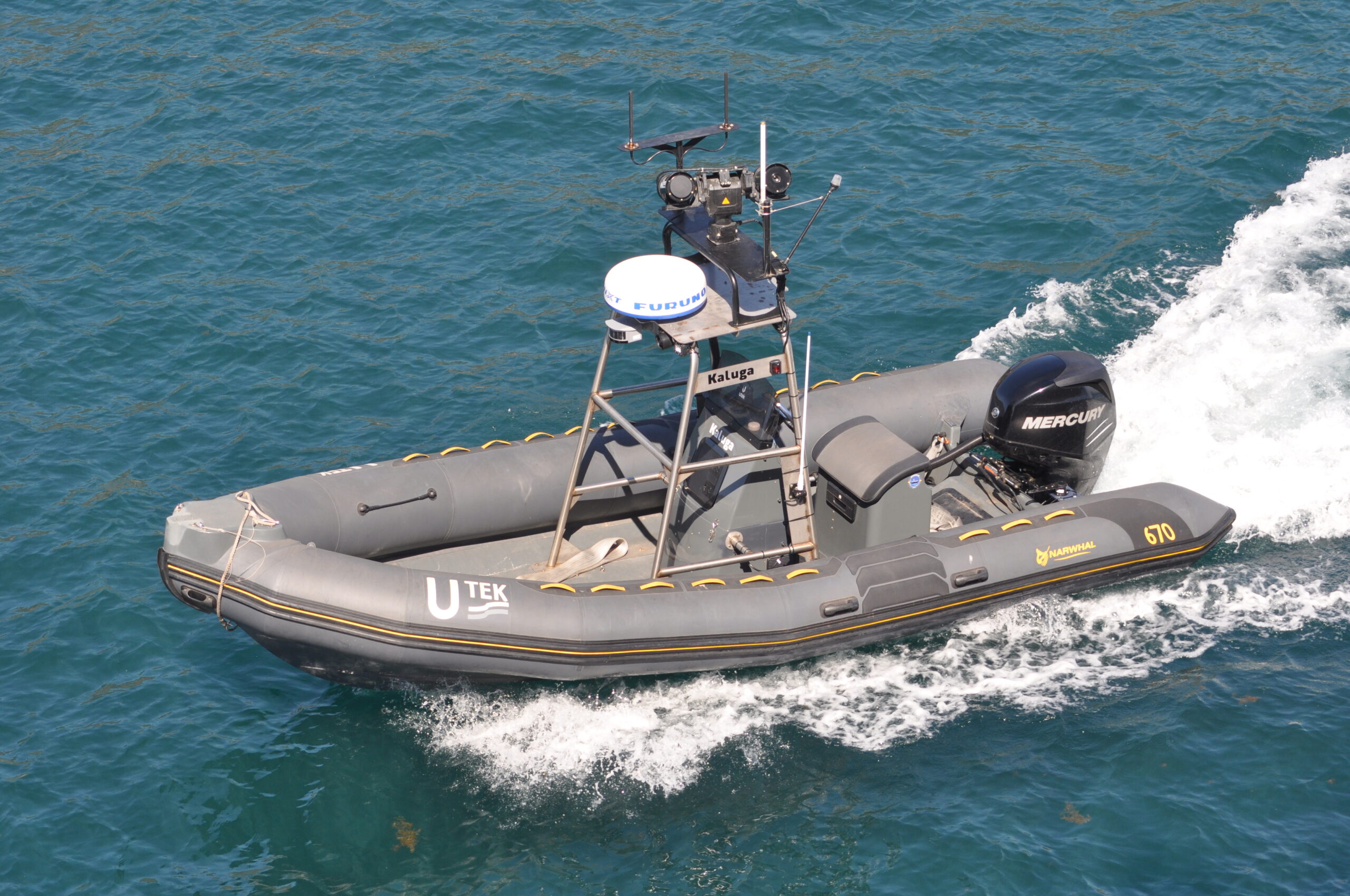
Credit: Peter Felstead
Another major objective of the exercise was to demonstrate the ability to use unmanned systems to conduct mine clearance operation from over the horizon. Addressing the threat from drifting mines was a further key aim. This involved serials designed to search for and classify suspicious surface objects using UAVs equipped with optical and laser imagery detection and ranging (LIDAR) sensors, allowing floating mine targets to be acquired and destroyed by explosive ordnance disposal (EOD) units.
A final challenge for the exercise was to explore how MCM assets could contribute to the protection of critical underwater infrastructure (CUI). For this purpose a three-day serial was devised in which a 700 m-long cable just 18.3 mm wide was laid at a depth of between 30 m and 50 m, with both legacy systems (manned MCM vessels) and unmanned assets used to find and track the cable, conduct change detection in its surroundings and identify any suspicious objects. This particular serial led to a real-life event on 25 September when an actual communications cable was discovered with a significant bend in it, the details of which were forwarded for further examination.
Passage to Sesimbra
The assets used for DM23 were mostly contained within a Task Group MCM (TG MCM) and a Task Group Surface (TG Surface). TG MCM consisted of assets from Standing NATO MCM Group 2, including its flagship, the Italian replenishment tanker ITS Stromboli, along with the Italian minehunter ITS Gaeta, the Spanish minehunter SPS Tambre, and the French diving tender FS Pluton.
TG MCM, meanwhile, included both two real vessels, the Italian frigate ITS Carabiniere and the Spanish offshore patrol vessel (OPV) SPS Furor, and two virtual ships, known as ‘VS London’ and ‘VS Lisbon’, which controlled real unmanned assets out of the Maritime Experimentation Operations Centre on Tróia.
On 26 September, ESD was on board SPS Furor as it conducted a passage from Troia to Sesimbra while simultaneously deploying four unmanned assets: the ship was flanked during the voyage by two USVs – Seadrone’s Sead-23 and the Kaluga from MILTECH Hellas – while an Alpha 900 rotary-wing UAV and a fixed-wing M5D-Airfox UAV were both launched and recovered during the voyage, the former from the ship’s helicopter deck while the latter was launched by hand and recovered by a net.
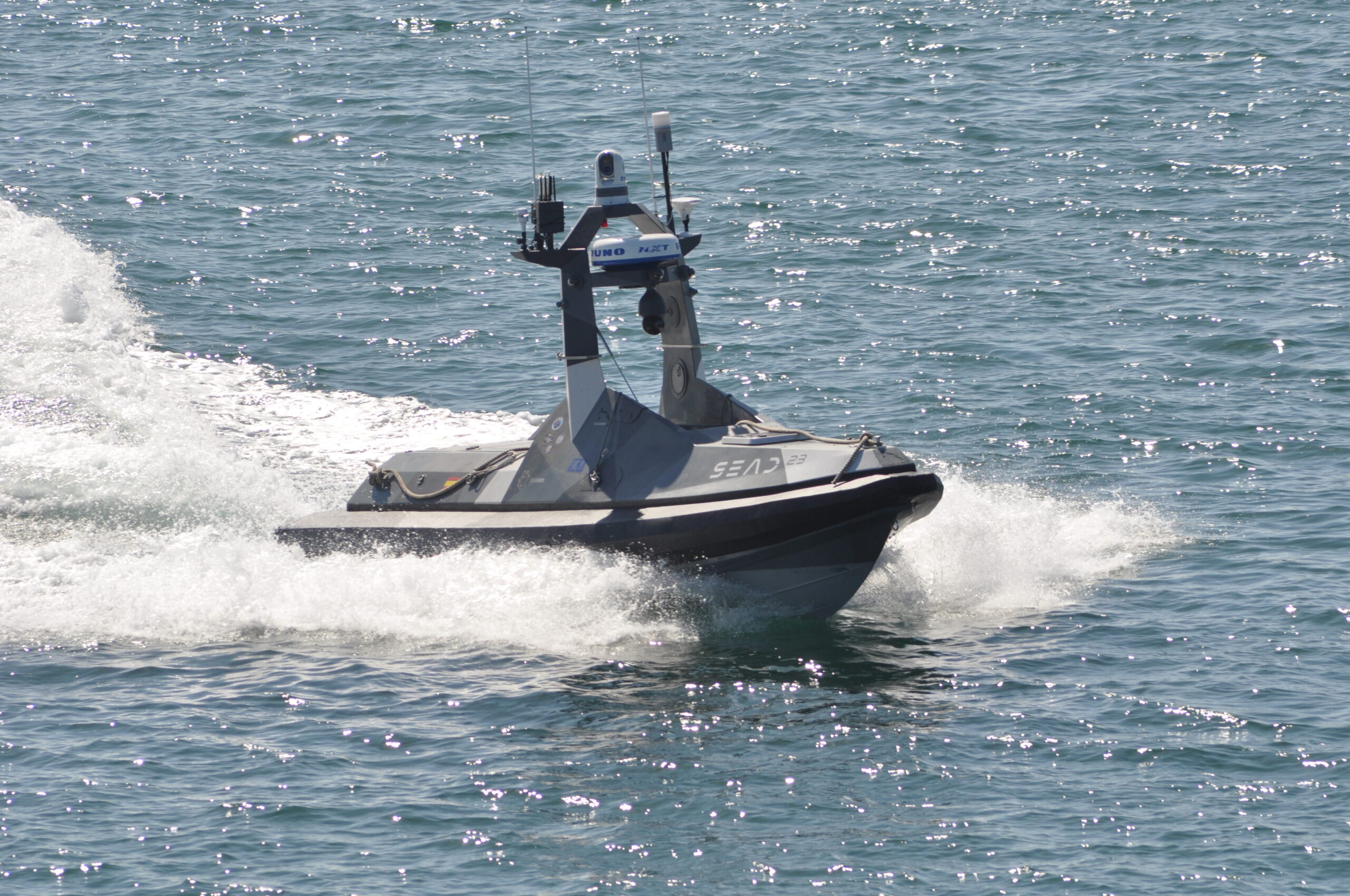
Credit: Peter Felstead
The 6.95 m long Sead-23, which features waterjet diesel propulsion, has a range of more than 322 km (200 miles) at 20 kts. It has a low radar cross-section (RCS) and typically carries day/thermal gyro-stabilised cameras, solid state radar, sounder and five high-resolution pilot cameras, although it can also carry other sensors and even a remote weapon station (RWS) armed with a 12.7 mm heavy machine gun (HMG).
The Kaluga, which Greece’s MILTECH Hellas developed with Leonardo Hispania and Spanish company UTEK, is effectively a USV based on a 6.75 m Narwhal 670 rigid-hull inflatable boat powered by a 150HP Mercury Verado outboard engine. It typically carries a MLT-SUR-100RTM thermal surveillance system, but can also mount other sensors or a Leonardo Lionfish Ultra Light RWS armed with a 12.7 mm HMG.
The fuel-powered Alpha 900 UAV has a maximum take-off weight of 25 kg, a payload capability of up to 4 kg and an endurance of up to four hours. The solar-powered M5D-Airfox, which weighs 4 kg and has a wingspan of 2.5 m, carries a high-definition video camera and has an endurance of 10 hours in optimal sunlight conditions (and 1.5 hours on its internal battery).
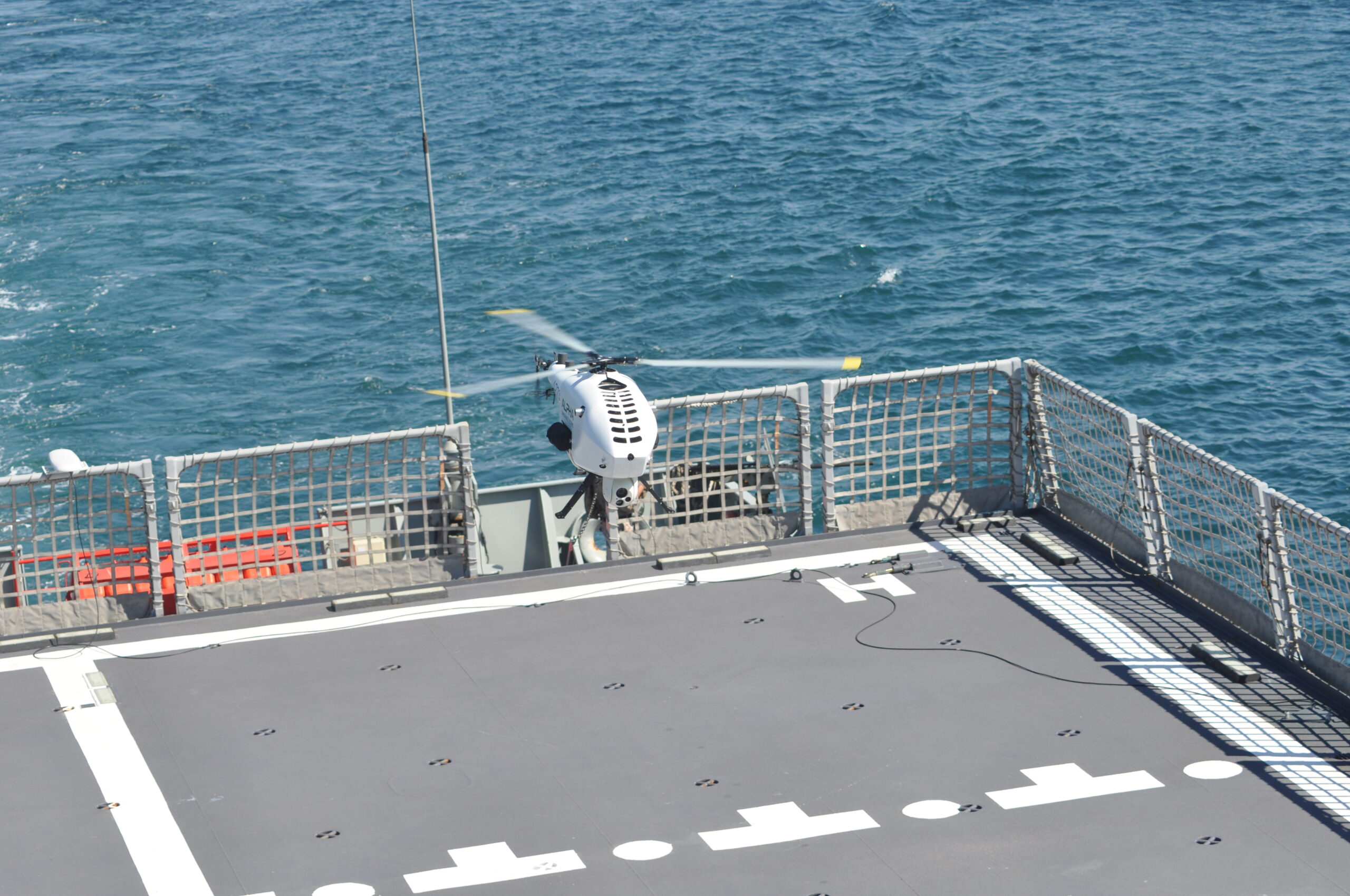
Credit: Peter Felstead
NAIAD: The Unmanned Enabler
At the heart of the ability of SPS Furor to simultaneously operate multiple unmanned assets is Navantia’s Naval Advanced Integrated Autonomous vehicles Defence (NAIAD) system. Designed specifically for the integration of UAV, USV and UUV operations, NAIAD has been designed as a flexible, open system that can be integrated into any combat management system (CMS) or command-and-control (C2) system, either on board a ship or in a control centre ashore. The NAIAD system was first demonstrated during ‘Dynamic Messenger 22’ (DM22), when it was integrated on the Spanish Navy OPV SPS Audaz.
NAIAD allows a ship’s crew to both monitor the data and sensor feeds from maritime unmanned assets on their CMS consoles and send missions to those unmanned assets. Communications between NAIAD systems at sea and ashore allows the sensor and data feeds from the unmanned platforms to be transmitted ashore. Additionally, an unmanned platform such as a UAV can be used as a relay between NAIAD systems at sea and ashore to extend the communication range between them, although for DM22 Navantia worked with Spanish company Hisdesat to demonstrate the transmission of NAIAD data via satellite link, thus obviating any range limitations or the need for communications relays.
Speaking to ESD on 25 September, Angelina Cajade Frias, Navantia’s European programme director, noted that the company is under contract to the Spanish Ministry of Defence to provide a new baseline configuration for the SCOMBA combat system used by the Spanish Navy’s surface combatants. This system update is effectively making these vessels ‘NAIAD ready’, with the control of UAVs and USVs being followed by the integration of UUVs as well. Cajade Frias added that she expects the NAIAD system will be procured for all of these ships “in the next few years”.
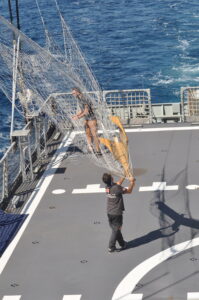
Credit: Peter Felstead
Part of Navantia’s roadmap also covers integrating the control of unmanned platforms with Spanish Navy submarines. As one of few such systems currently available, Navantia is now starting to market NAIAD to a prospective customer base beyond the Spanish Navy.
“At this time Spain is the unique nation that has NAIAD, but Navantia has the objective to sell it to other navies,” Cajade Frias told ESD. “Currently, there are only a few systems similar to NAIAD in the market that have demonstrated its capabilities in real operations. Navantia has received information requests about NAIAD after its participation in ‘Dynamic Messenger’.
The CUI Challenge
The need to protect critical underwater infrastructure (CUI) was a particularly apposite objective for DM23, given that the exercise dates straddled the first anniversary of the 22 September 2022 attacks on the Nordstream pipelines in the Baltic Sea.
Briefing an audience at Sesimbra on 26 September, Thomas Furfaro, a project leader with the NATO Science and Technology Organization’s Centre for Maritime Research and Experimentation, outlined a number of questions DM23 was looking to address in the specific area of CUI protection. These were:
- Can acoustic sensors provide sufficient fidelity to allow operators to identify contacts without optical sensing? (which relies on relatively clear water to be effective);
- Can the pace and resilience of MCM operations be improved by broader interoperability between systems?
- How can operators and systems be evaluated in terms of their real and self-estimated performance?
One serial in relation to the latter question involved a mystery target being dropped onto the sea floor, with a UUV’s sonar then used to try and determine its shape and characteristics.
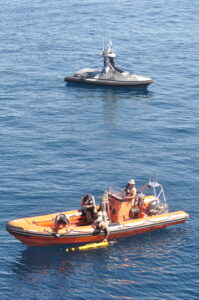
Credit: Peter Felstead
Asked by ESD whether maximising the effectiveness of acoustic sensors involved exploiting capabilities such as AI to get the most out of current sensors, or whether new technology was the answer, Furfaro noted that, while DM23 was focusing on the former, the development of new, high-frequency sonars systems could ultimately provide an enhanced capability.
Manned Versus Unmanned
By the time ESD’s visit to DM23 concluded on 26 September, a number of the exercise’s objectives had already been met. For example, of 24 mine targets laid, all had been found. With the exercise’s conclusion, meanwhile, there will be much data to pore over.
Ultimately, much of the exercise was about whether – using maritime unmanned vehicles in all their forms, relying more significantly on autonomous capabilities and AI, and employing systems such as Navantia’s NAIAD – unmanned vehicles addressing the MCM mission can match and eventually surpass the capability of manned MCM assets.
The pitching of manned versus unmanned assets was evident in the maps of the exercise area, which showed that, while legacy manned assets were focused on mine targets in a number of exercise boxes to the southwest of the Troia peninsula, the unmanned assets were focused on an area along the coast below Sesimbra.
According to the commanders in charge of DM23, the current situation is that NATO’s unmanned and autonomous capabilities are not quite at the proficiency levels of legacy manned MCM vessels. However, this is precisely the situation that REPMUS 23, DM23 and their subsequent iterations are designed to reverse.
Peter Felstead


